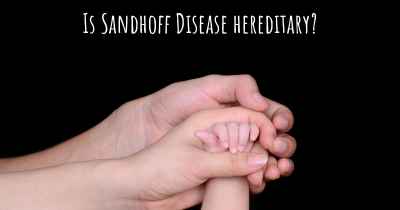9
What is the life expectancy of someone with Sandhoff Disease?
Life expectancy of people with Sandhoff Disease and recent progresses and researches in Sandhoff Disease

There are three types of Sandhoff disease, classic infantile, juvenile, and adult late onset. Each form is classified by the severity of the symptoms as well as the age at which the patient shows these symptoms.
Classic infantile form of the disease is classified by the development of symptoms anywhere from 2 months to 9 months of age. It is the most severe of all of the forms and will lead to death before the patient reaches the age of three. This is the most common and severe form of Sandhoff disease. Infants with this disorder typically appear normal until the age of 3 to 6 months, when development slows and muscles used for movement weaken. Affected infants lose motor skills such as turning over, sitting, and crawling. As the disease progresses, infants develop seizures, vision and hearing loss, dementia, and paralysis. An eye abnormality called a cherry-red spot, which can be identified with an eye examination, is characteristic of this disorder. Some infants with Sandhoff disease may have enlarged organs or bone abnormalities. Children with the severe form of this disorder usually live only into early childhood.
Juvenile form of the disease shows symptoms starting at age 3 ranging to age 10 and, although the child usually dies by the time they are 15, it is possible for them to live longer if they are under constant care. Symptoms include autism, ataxia, motor skills regression, spacticity, and learning disorders.
Adult onset form of the disease is classified by its occurrence in older individuals and has an effect on the motor function of these individuals. It is not yet known if Sandhoff disease will cause these individuals to have a decrease in their life span.
Juvenile and adult onset forms of Sandhoff disease are very rare. Signs and symptoms can begin in childhood, adolescence, or adulthood and are usually milder than those seen with the infantile form of Sandhoff disease. As in the infantile form, mental abilities and coordination are affected. Characteristic features include muscle weakness, loss of muscle coordination and other problems with movement, speech problems, and mental illness. These signs and symptoms vary widely among people with late-onset forms of Sandhoff disease.
Classic infantile form of the disease is classified by the development of symptoms anywhere from 2 months to 9 months of age. It is the most severe of all of the forms and will lead to death before the patient reaches the age of three. This is the most common and severe form of Sandhoff disease. Infants with this disorder typically appear normal until the age of 3 to 6 months, when development slows and muscles used for movement weaken. Affected infants lose motor skills such as turning over, sitting, and crawling. As the disease progresses, infants develop seizures, vision and hearing loss, dementia, and paralysis. An eye abnormality called a cherry-red spot, which can be identified with an eye examination, is characteristic of this disorder. Some infants with Sandhoff disease may have enlarged organs or bone abnormalities. Children with the severe form of this disorder usually live only into early childhood.
Juvenile form of the disease shows symptoms starting at age 3 ranging to age 10 and, although the child usually dies by the time they are 15, it is possible for them to live longer if they are under constant care. Symptoms include autism, ataxia, motor skills regression, spacticity, and learning disorders.
Adult onset form of the disease is classified by its occurrence in older individuals and has an effect on the motor function of these individuals. It is not yet known if Sandhoff disease will cause these individuals to have a decrease in their life span.
Juvenile and adult onset forms of Sandhoff disease are very rare. Signs and symptoms can begin in childhood, adolescence, or adulthood and are usually milder than those seen with the infantile form of Sandhoff disease. As in the infantile form, mental abilities and coordination are affected. Characteristic features include muscle weakness, loss of muscle coordination and other problems with movement, speech problems, and mental illness. These signs and symptoms vary widely among people with late-onset forms of Sandhoff disease.
Posted Feb 24, 2017 by Levi Christopher Lucero, Jr. 2185
Translated from spanish
Improve translation
Is that the life expectancy of the baby does not pass the 3 years unfortunately
Posted May 11, 2017 by Mara 700








